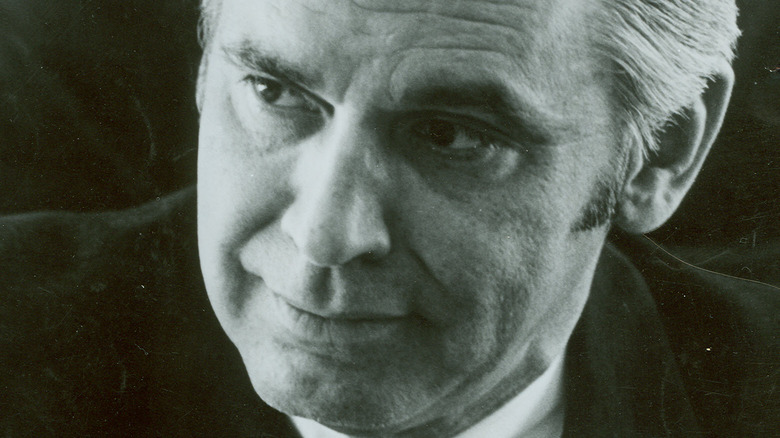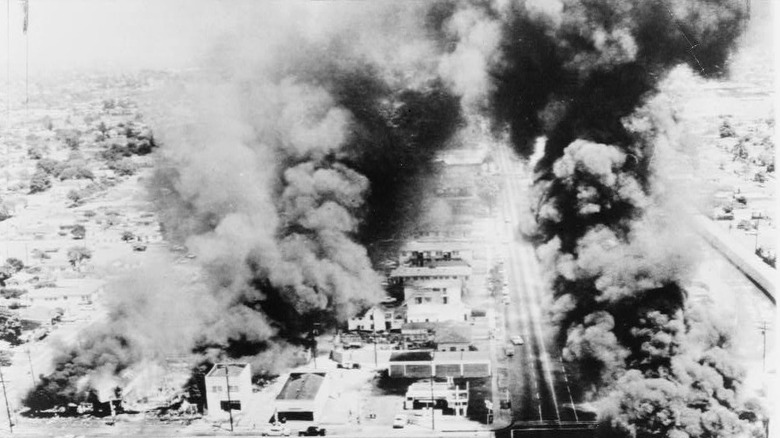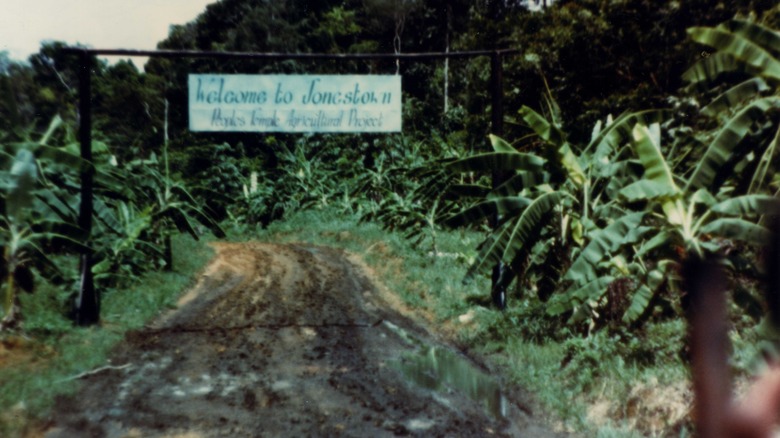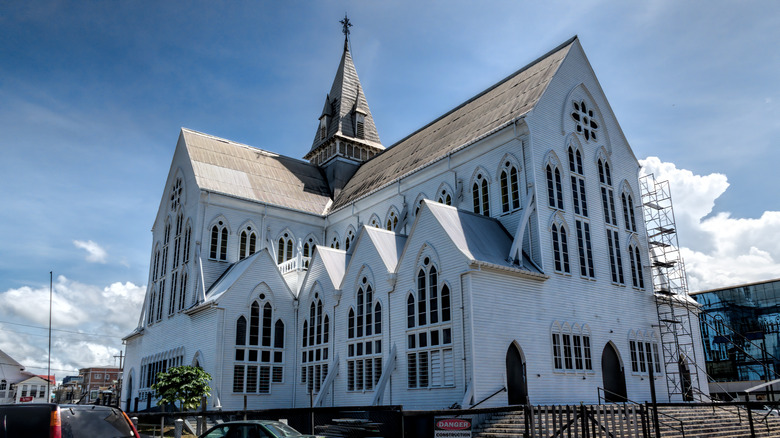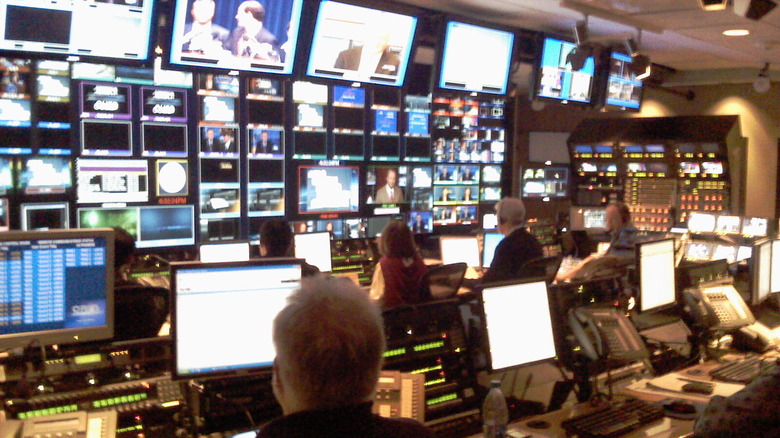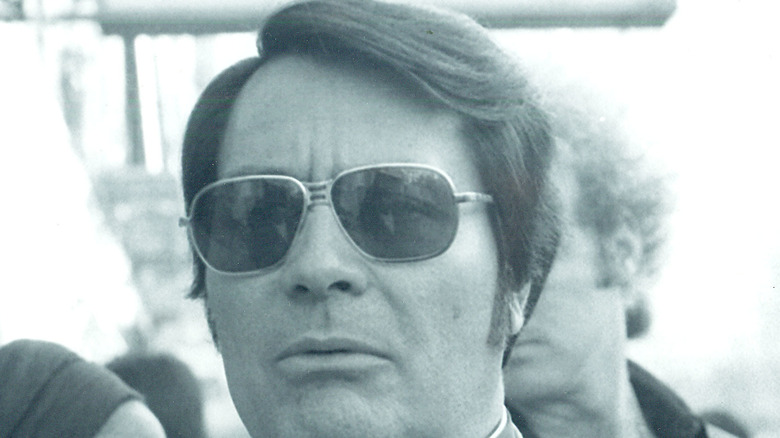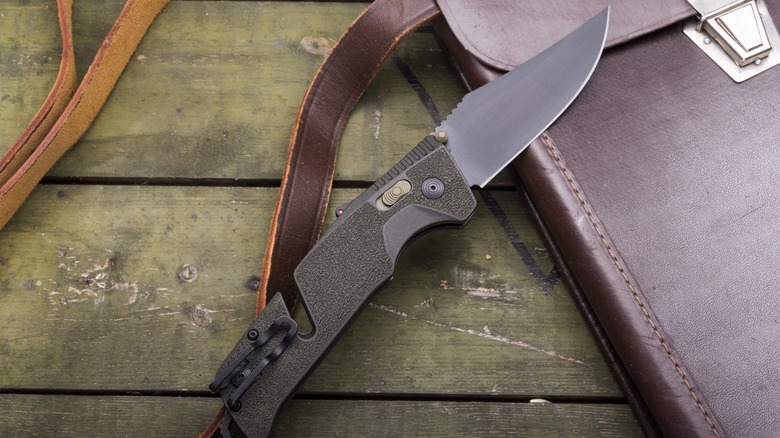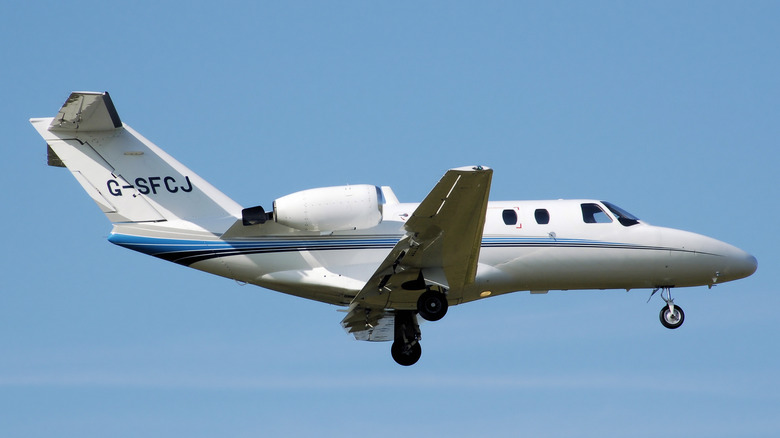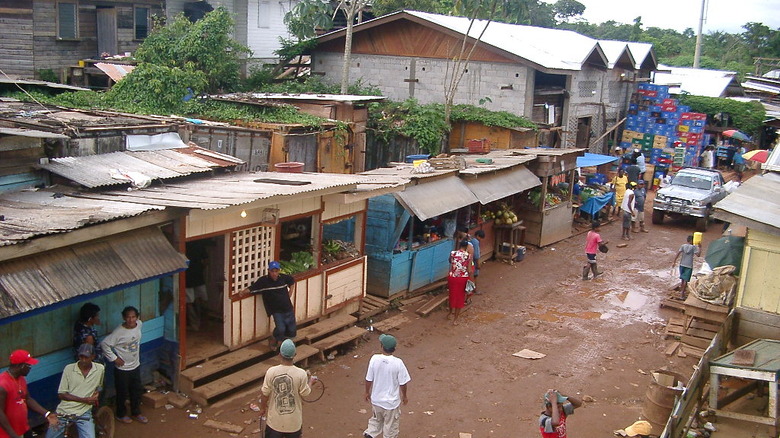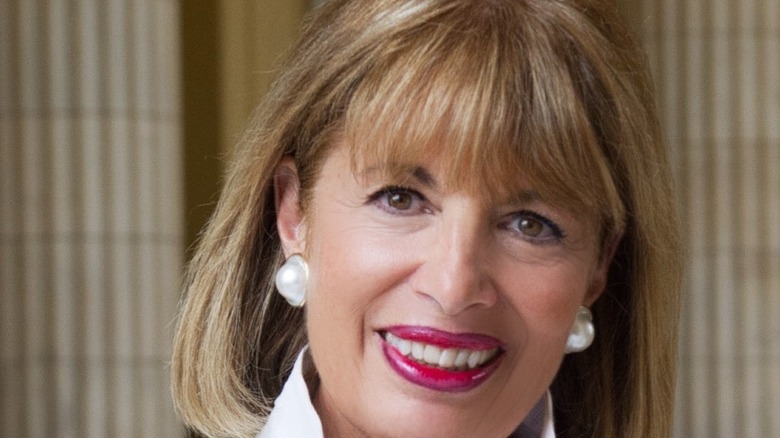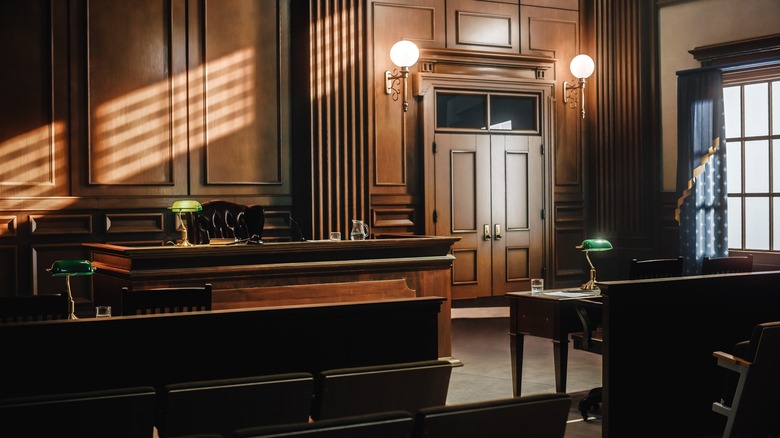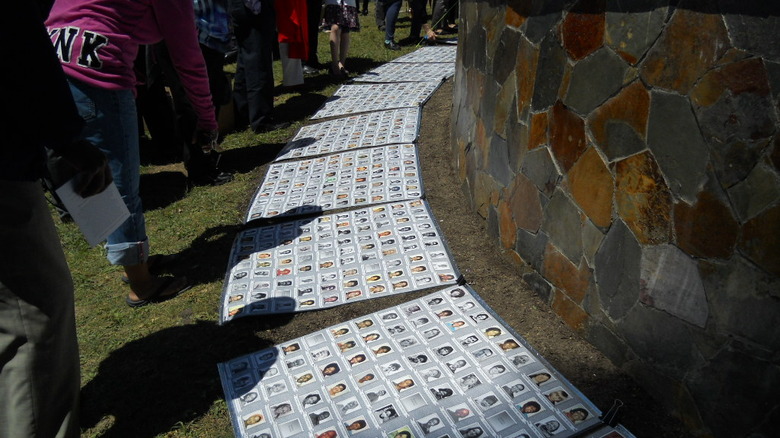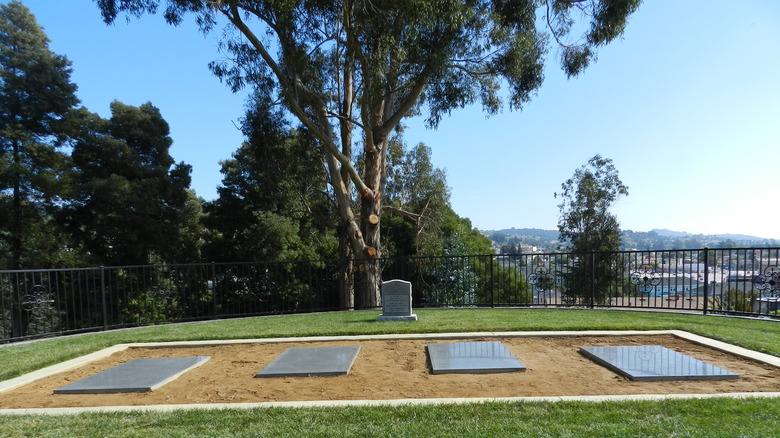Chilling Details About The Murder Of US Congressman Leo Ryan
California politician Leo Joseph Ryan started out as a teacher in San Francisco but was inspired to run for political office by President John F. Kennedy's call to service during his inaugural address in 1961. From the get-go, he was extremely hands-on and organized several detailed investigations, which he took on by going undercover, according to PBS.
Looking into Jim Jones' Peoples Temple and Jonestown in Guyana was to be one such fact-finding mission. Ryan was initially interested in the Peoples Temple because of a series of newspaper articles in the San Francisco Examiner. After organizing a small group to fly to Guyana, Ryan and his entourage set off on what became a two-day trip. Ryan, along with four others, never returned.
Several Peoples Temple members started firing on the airstrip where Ryan, his party, and several defected Temple members were waiting to board the two planes that would take them from Guyana. The survivors boarded up at a nearby house after the attack. Some time later, Jones decided to proceed with his plan of mass suicide for the residents of Jonestown, which had long been planned. Ultimately, Ryan's actions may have precipitated the mass suicide at Jonestown but did assist world governments with assessing further ways of interacting with cults.
If you or anyone you know is having suicidal thoughts, please call the National Suicide Prevention Lifeline at 1-800-273-TALK (8255).
He went undercover for his constituents
Leo Ryan worked as a high school English and history teacher for years, after a childhood moving constantly around the country, writes PBS. He was first elected to the city council of South San Fransisco and was later elected to the California State Assembly in 1962. Later, as a congressman, he effectively went undercover to learn about certain issues; after the Watts riots in 1965, he worked as a substitute teacher in the area to learn more about how families lived there. His friend George Corey said of Ryan (per PBS): "He would march into the heart of hell to see it firsthand." While serving on a prison reform committee, Ryan underwent a 10-day prison stay at Folsom prison to see how the prisoners lived and reported back to the State Assembly, according to SFGate.
The San Mateo Daily Journal writes that when Ryan was elected to Congress in 1972, he was vehement about the work he was either for or against; he was against the Vietnam War and the killing of seals in Newfoundland, which he personally visited. Ryan was also concerned about cults, which ultimately led to his last fact-finding trip.
A mutilated body in a train yard
By the late 1970s, rumors of human rights violations at the Peoples Temple in Jonestown in Guyana began to surface. What sparked Leo Ryan's interest specifically was a San Fransisco Examiner article about the mutilation and death of Bob Houston, the son of Ryan's friend and a member of the Peoples Temple. Houston's body was found in October 1976, mutilated in a freight train yard; he had reportedly just had a conversation with a family member about leaving the Peoples Temple. His father alerted Ryan to the death; he was concerned that he had no way of speaking with his grandchildren, and Ryan agreed to look into it (via San Diego State University).
In addition to being concerned about Houston's death, Ryan was also in talks with members of the Concerned Relatives group. This was a group of former Peoples Temple members whose relatives were still members, and they were worried about their stay in Jonestown as well as mistreatment, according to San Diego State University. The leader of the Concerned Relatives group at that point was Tim Stoen, who was in a custody battle with Jim Jones over the young boy John Victor Stoen, who may have been Jones' biological son (via San Diego State University). After hearing about the custody battles from Stoen and stories of abuse from defectors, Ryan planned to go to Jonestown himself and continue his investigation.
Leo Ryan was determined to go to Jonestown, despite opposition
Toward the end of 1978, Leo Ryan resolved to go to Guyana to visit Jonestown and continue to investigate it in person. This was the same kind of investigation he did all the time, and he sent a telegram to Jim Jones asking to visit. The tone of the telegram made it clear he was being polite but expected to be accepted; while being firm about his visit, Ryan also asked about the work that was being done in Jonestown (via San Diego State University).
Though visiting Jonestown was his plan, Ryan was also under a tremendous amount of pressure from members of the Concerned Relatives group and Tim Stoen in particular, who had by then sent eight requests for Whereabout and Welfare checks for John Victor to the State Department (via San Diego State University).
The State Department attempted to dissuade him but to no avail. Ryan ultimately traveled to Jonestown with his aides, members of the Concerned Relatives group, several journalists (including Tim Reiterman), and an NBC News crew.
He intended to use the press as a weapon
Before Leo Ryan's visit, members of the Peoples Temple signed several statements saying they had no intention of seeing him and also charged members of the Concerned Relatives group with harassment, writes San Diego State University. Though they requested that Ryan not bring the media or representatives of the Concerned Relatives group on his visit, he did both.
Ryan was planning on using the press to force the truth about Jonestown to come to light. According to journalist Tim Reiterman via SDSU, he was "counting on the news media to help him get into Jonestown and to bring out anyone who wanted to leave... In a way, he viewed the press as a key element in forcing out the truth about Jonestown and as protection; the glare of publicity might inhibit any Temple inclinations to cause trouble." Ryan had been investigating Jonestown for months, and his interest was piqued for years.
However, the closer scrutiny and high probability of further investigation likely caused Jim Jones to act and continue the preparations for mass suicide of the Jonestown community, postulates SDSU. Throughout the process, it is likely that Ryan believed he would be denied entry at Jonestown and leave soon after. Ryan would then use the refusal as a reason for Congress to investigate further.
He was unaware of Jones' deteriorating mental state
Certain information, specifically knowledge of Jim Jones' failing mental state, was not given to Leo Ryan by the State Department. Ryan was also not informed of just how contentious the custody battle had become between the Stoens and Jim Jones over the young John Victor Stoen. Regardless, Ryan determined to go to Guyana. Once his group arrived at Jonestown, his entourage was initially welcomed. However, two Peoples Temple members passed Ryan a note on the first day saying they wanted to leave. The whole trip had an uneasy pall over it, clearly seen in Tim Reiterman's recounting for AP News.
The group demanded to see the squalid houses where Jonestown residents lived, which Jones likely wasn't expecting, writes Reiterman for AP News. The strange nature of the visit continued with a custody battle over a baby whose father wanted to take with him from Jonestown while the mother wanted to stay. Ultimately, the group of defectors grew to at least 16.
San Diego State University writes that while Ryan was visiting, Jones was clearly physically ill and was terribly worried about what would happen to John Victor should Jones himself leave Jonestown. It was clear that Ryan's visit was an additional stress for Jones — and it would soon wreak disaster on his community.
Leo Ryan was attacked with a knife
The day Leo Ryan was to leave — the day after he had arrived — he was attacked with a knife by a Peoples Temple member. The man had held a knife to his throat and said he would slit it. The Temple's lawyers, as well as Ryan himself, managed to calm him down. Though Ryan was not severely injured, the incident sped up the pace of the group's departure, writes Tim Reiterman in AP News. It had been raining that day, and everyone slid toward the truck in the mud. The truck took off soon after Ryan got inside, blood smeared on his shirt and pants.
According to Reiterman in AP News, Ryan had actually intended to stay longer at Jonestown to be with would-be defectors who couldn't get seating on the planes. However, the knife attack alerted Jim Jones' adopted son Johnny to the fact that the visitors needed to leave as soon as they could, or things would get worse. On their way to the airstrip, two other men stopped the truck for a search but didn't find who they were looking for: Namely, a woman who had taken her child with her and was planning to go to the U.S. Reiterman recalled that some people thought the men would fire on the truck and everyone on it, but the group did make it to the airstrip safely.
Layton shot from the plane
While on the Port Kaituma airstrip, the group was split in two to board two planes: a six-passenger Cessna and a Guyana Airways 24-seater. Everyone was searched, though Larry Layton, a Peoples Temple member who was close to Jim Jones but who had volunteered to leave with Ryan, attempted to get out of it at first (via AP News). According to San Diego State University, Tim Reiterman had noticed while on the truck that Layton had something in his waistband but was unable to conclusively determine whether or not it was a gun. Ryan's aide, Jackie Speier, just had a gut feeling that something was wrong (via Roll Call).
Soon after arriving at the airstrip, Layton began shooting on the Cessna. He failed to hit the Cessna's pilot but succeeded in shooting Monica Bagby and Vernon Gosney, two Temple defectors; he also misfired at Dale Parks, who managed to wrestle the gun from him, writes Reiterman in AP News. Layton was ultimately taken into custody by Guyanese officials; they also took a .38-caliber pistol from him.
Leo Ryan was shot on the airstrip
At the same time as Larry Layton began shooting on the Cessna, a truck full of Peoples Temple members, who had arrived at the airstrip at the same time as Leo Ryan and his party, also began shooting. Ultimately, Ryan was killed along with four others, including three members of the media and former Temple member Patty Parks. Five people were severely wounded, five were minorly wounded, nine were uninjured, and six were lost or ended up hiding, according to Tim Reiterman, a journalist who was injured in the airstrip shooting, via AP News.
Eleven others from Jonestown were listed as airport shooters by the FBI afterward, writes San Diego State University. Camera operator Bob Brown, who was killed during the shooting, managed to film a few seconds of footage of the shooters before the attack began. Ultimately, Ryan gave his life for an investigation that was never really completed.
Survivors waited an entire day for transport
Leo Ryan's aide Jackie Speier reportedly waited 22 hours for help after being shot five times on the Guyana airstrip, according to Roll Call. When the shooting started, she followed Ryan to hide underneath one of the wheels.
Tim Reiterman recalled being put up in a nearby house the night after the shooting, jumping at every loud sound, writes AP News. One of the civilians who put up the group said he had a feeling something like this would happen and was afraid of it. A guard station made up of Guyana civilians was set up over the course of the night to protect the wounded; the State Department had not sent a military escort with Ryan's group.
Speier had spent so much time hearing stories about Jim Jones from members of the Concerned Relatives group that before she went to Jonestown, she added a line in her signing papers for a new condo that her contract would be void if she died during the trip. Ultimately, she did survive, but she also spent months in the hospital and underwent 10 different surgeries. She said afterward (via Roll Call), "I thought to myself, I don't want to spend the rest of my life a victim of Guyana. I want to be a survivor."
Layton was convicted for conspiring in Ryan's murder
Larry Layton was convicted in 1986 for conspiring in Leo Ryan's murder. As of that year, he was the only Peoples Temple member to be brought to trial in the U.S., writes AP News. He was also convicted for aiding and abetting in the attempted murder of diplomat Richard Dwyer, who was wounded during the airstrip shooting. Layton was originally tried in 1981, but the trial ended in a hung jury.
Layton admitted to working with Jim Jones on a plot to prevent Ryan from reaching the U.S. with the information he had gained about the conditions at Jonestown. Layton was ultimately sentenced to life in prison in 1987 with the possibility of parole in five years, with credit given for the year he had already served, according to AP News.
During his statement before the sentencing, Layton said (per AP News): "I know it was a horrible thing ... so many people that were lured into Peoples Temple and lured into Jonestown. I only wish there was something I could do that would somehow ease the pain of those people." Layton was released from federal prison in 2002 (per San Diego State University).
Jones panicked about more visitors after Ryan
Soon after Leo Ryan's group left Jonestown, the possibility of more scrutiny from the outside world ultimately caused Jim Jones to act. As journalist Tim Reiterman put it via AP News, two days after the first tragedy, "We couldn't know then that the grim little world of this sick man would shatter within hours, taking hundreds of his followers to their deaths."
Jones gathered everyone into the main pavilion and had them participate in what he called a "revolutionary act," writes History. A fruit drink laced with cyanide and sedatives was given to everyone, including children. Those who refused to drink were injected. Nine hundred nine dead bodies were found the next day, November 19, by Guyanese officials.
Several members slipped into the trees as the ritual went on, therefore surviving, and several others survived simply because they happened to be in another part of Guyana, including several of Jones' sons (via History). Other than Larry Layton, the rest of the shooters on the airstrip went back to Jonestown and participated in the mass suicide, according to AP News.
If you or anyone you know is having suicidal thoughts, please call the National Suicide Prevention Lifeline at 1-800-273-TALK (8255).
Leo Ryan's approach changed how the government assesses cults
Ultimately, Leo Ryan went to Jonestown to fulfill his oath to concerned relatives; over his time in office, he had become a very hands-on congressman, writes PBS. In 1983, he was posthumously awarded the Congressional Gold Medal for his work. Though one interpretation concedes that Ryan's actions indirectly lead to hundreds of deaths at Jonestown and on the Port Kaituma airstrip, Ryan's aide Jackie Speier said afterward that she believed nothing would have dissuaded him from going to further investigate Jonestown, writes Roll Call.
His investigation and the aftermath forever changed the way governments interact with cults and other groups that isolate themselves from the outside world, according to San Diego State University. A major element that began to matter was whether these groups were thought to be violent, to hold weapons, or to hold people or children who could be used as hostages during whatever stand-off might occur. FBI agent John Douglas's work with criminal profiling has also become revolutionary while investigating cults and other groups.
